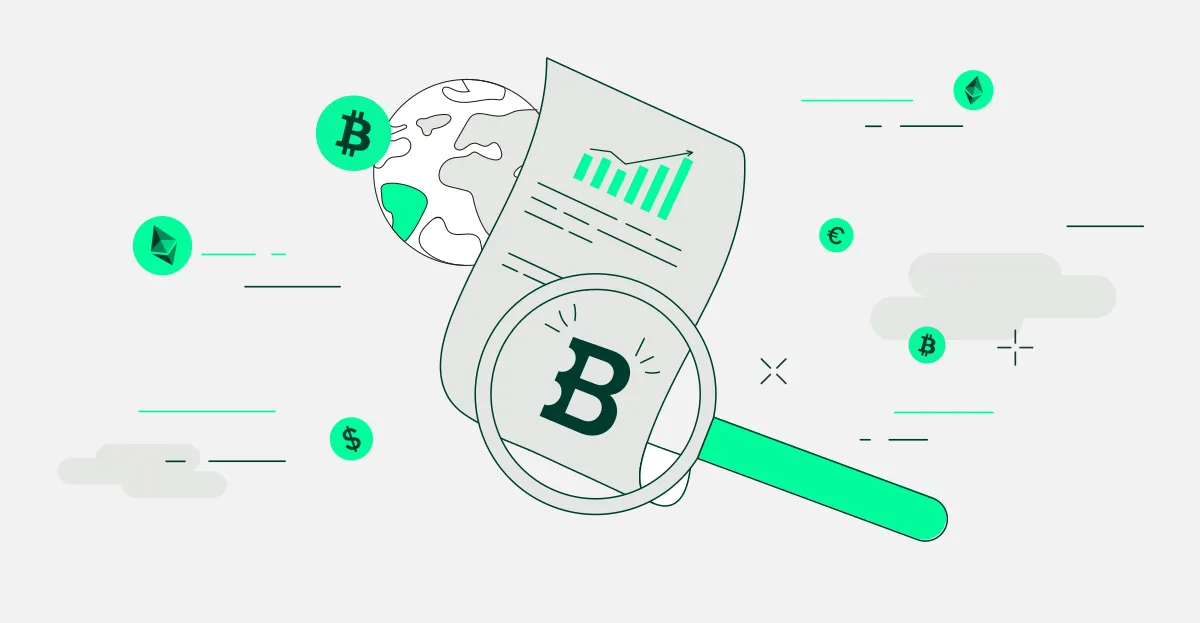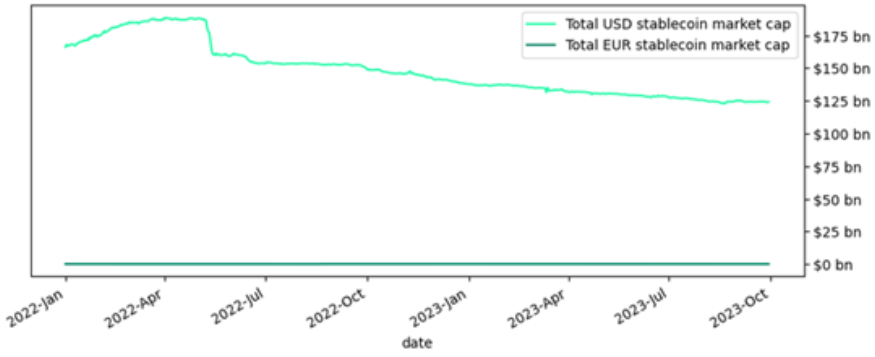Bitstamp Monthly Briefing – September 2023

The total crypto market cap increased by 2.7% MoM and reached $1.06tn at the end of September. Trading volume at leading crypto spot exchanges we track decreased by 17% in the same period, dropping to $232bn.
BTC dominance increased by 0.7 pp MoM to 49.8%.
Total crypto market cap (grey) and BTC dominance (green)

Best performing CMC 100 assets in September
- +39.4% Chainlink (LINK) - Chainlink launched on Arbitrum
- +32.9% Maker DAO (MKR) - Successfully tested $1k resistance level
- +28.3% ThorChain (RUNE) - The key factor is the accelerating speed of Thorchain’s flywheel mechanism
Worst performing CMC 100 assets in September
- -24.3% Gala (GALA) - Ongoing legal issues among founders negatively resonate on the market
- -19.2% Flare (FLR) - Failed to hold near-term support at $0.013
- -14.5% Klaytn (KLAY) - The price broke down from long-term horizontal support at $0.14
Key macro & crypto events in October 2023
- October 6: US Non-Farm Payrolls
- October 11: FOMC Minutes
- October 12: US Inflation Rate
- October 18: GB Inflation Rate
- October 22-25: Money 20/20 (Las Vegas)
- October 26: ECB Interest Rate & Press Conference
- October 31: EU Inflation Rate
Token 2049 Debrief: Q&A with Bitstamp attendees
Fresh from Token 2049, Asia's crypto hotspot, we're excited to share our experiences! This year's conference was nothing short of energetic and intense, and we can't wait to provide you with a glimpse into the insights, trends, and excitement we encountered.
Token 2049 was hosted in the vibrant heart of Asia's crypto hub, Singapore, reaffirming its status as the continent's premier crypto event. At the event, we witnessed a dynamic ecosystem where innovation thrives, bringing together a diverse community of builders, venture investors, and traders. It was a week filled with non-stop learning, networking, and excitement, amplifying the energy and intensity of the event.

Some of the top topics that resonated during the conference included the growing regulatory frameworks across the APAC region, seen as critical for future growth, and the strategy of building in a bear market to better position for future bull markets garnered substantial attention.
Over the next 12 months, our peers in the industry were particularly excited to follow three major trends: the development of the stablecoin market, the emergence of the next wave of engaging P2E games, and efforts to address the debanking challenges in the industry, focusing on banking partnerships and on/off ramps.
This year's Token 2049 felt notably distinct from previous editions. It was much larger, featuring a higher quality of projects at the exhibition booths. The event saw a shift towards a more institutional crowd, aligning with its intended audience. The speaker lineup was exceptionally strong, featuring industry leaders from across the ecosystem. Perhaps the most significant impact on our perspective towards the industry was the emphasis on the need for collective collaboration efforts to drive the industry forward.
As we reflect on our time at Token 2049, we're excited to share these insights and inspirations. The energy, intensity, and sense of collaboration at the event have ignited our passion for innovation in the crypto space.
The Utility Case for Stablecoins
The emergence of stablecoins calls back to the origins of eurodollars in the 1950s, as was pointed out by Nic Carter at the recent Token2049 event. Eurodollars are USD-denominated liabilities of a bank located outside the US. Eurodollars originated from the swift post-war growth of European exports to the US, developing as a response to US banking market restrictions while maintaining a desire for global USD transactions.
As mentioned above, the emerging stablecoin industry reflects some noteworthy characteristics of eurodollars. For example, the majority of USD stablecoins are issued offshore (ca. 75%), they allow users to bypass the need for a banking middleman, and they offer a more flexible form of capital for a globalized market. Furthermore, the stablecoin market is overwhelmingly dollarized, with USD-denominated stablecoins representing ca. 99% of all stablecoin supply.
Stablecoins are systemically important in cryptocurrency markets. While they may represent only ca. 10% of the entire crypto market cap, they constitute 74% of all cryptocurrency transactions on centralized exchanges, i.e., most of the crypto activity incorporates stablecoins, not fiat. However, the stablecoin supply has been slowly reducing during the duration of the bear market.

Source: DefiLlama
The demand for quicker and cheaper movement of capital has also been recognized by non-crypto native firms. The latest addition to the USD-backed stablecoin roster is payment processing giant PayPal, with its PayPal USD or PYUSD. PYUSD hit the market at the end of August 2023 and was also recently listed on Bitstamp. PayPal aims to ease in-house transactions for its users and provide them with an alternative payment method for purchasing goods and services.
Looking to the future, the recent popularity of non-USD stablecoins also showcases stablecoins’ utility in FX markets and global remittance, to beat the slow pace and high costs of the global remittance corridors, which were estimated at $831 billion in 2022.
Recommended reads
Emerging Catalysts in Crypto – the Industry’s Parallels to Maturity in Equities by Pantera
Tokens are emerging as a new form of capital formation and may replace traditional equity for businesses, meaning companies may just have a token instead of stock exchange listed equity. This piece's central argument is that digital asset prices will be driven more by their fundamentals, like traditional finance rules.
Bitcoin – The Cantillon Effect, And Why It’s an Issue by Percy
The Cantillon Effect posits that the timing of receiving newly created money determines its impact. With the debt-to-GDP ratio growing wider, it’s hard to deny that the Cantillon Effect is real. The author argues that a Bitcoin Foundational Layer could solve this problem.
What Happens When You Send Money Abroad? By Alex Rampell of a16z
$8 trillion moves between different currencies every single day in the biggest market in the world. The article explains why it’s expensive and complicated, why are people trying to disrupt it (or not disrupt it), and how it actually works.
Freedom Through Interoperability with Jimmy Chang
In the early September edition of On The Other Side, Chang investigates why interoperability is important for a multi-chain future.
No information in this blog is intended to provide any personal investment services or advice nor is it an investment recommendation. Clients are responsible for making their own investment decisions. Bitstamp accepts no responsibility for any damage and/or loss arising from the use of information provided herein. Past performance is not necessarily an indicator of future results. Please consider your individual position and financial goals before making an independent investment decision.
Bitstamp is licensed to engage in virtual currency business activity by the New York State Department of Financial Services. Licensed as a Money Transmitter by the New York State Department of Financial Services
Not offered in the following states: Hawaii and Nevada
Bitstamp UK Limited is registered with the Financial Conduct Authority under the Money Laundering, Terrorist Financing and Transfer of Funds (Information on the Payer) Regulations 2017.
This webpage has been approved as a financial promotion by Bitstamp UK Limited which is registered with the UK’s Financial Conduct Authority. Please read the Risk Warning Statement before investing. Cryptoassets and cryptoasset services are not regulated by the Financial Conduct Authority. You are unlikely to be protected if something goes wrong. Your investment may go down as well as up. You may be liable to pay Capital Gains Tax on any profits you earn.